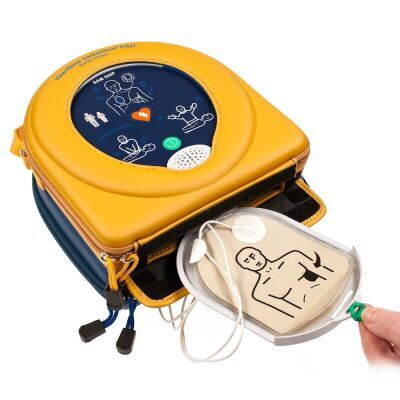Key link in the chain of survival
Cardiopulmonary Resuscitation (CPR) and Automated External Defibrillators (AEDs) are key links in the chain of survival of sudden cardiac arrest (SCA). Some cardiac events are treatable with effective CPR alone. Others require a combination of effective CPR and the delivery a lifesaving shock by an AED. Either way, every minute counts.
Only about five percent of SCA victims survive. However, survival rates can increase up to 74%3 if CPR and a shock from an AED are provided within three minutes of collapse. Reducing response time by even one or two minutes from collapse to shock can mean the difference between death and survival.
Offering real-time CPR feedback, the HeartSine samaritan PAD 500P (SAM 500P) Automated External Defibrillator (AED) with CPR Advisor meets the needs of two key links in the chain of survival. Not only can the SAM 500P deliver a lifesaving shock, it provides real-time visual and verbal feedback to the rescuer on the force and rate of CPR compressions during an SCA resuscitation — effectively assisting the rescuer to perform CPR.
Real-time CPR feedback
Integrated real-time CPR feedback
- Easy-to-understand visual and voice prompts guide the rescuer through the entire resuscitation process, providing specific feedback on the force and rate of compressions.
Ready to shock
Unique Pediatric-Pak
- Ensures the guidelines-recommended energy level is delivered for children, between 1 and 8 years of age or up to 25 kg (55 lb).
High level of protection from dust and water
- Offers IP56 rating, one of the highest ratings in the industry.
Clinically validated technology
- Advanced electrode technology and SCOPE biphasic technology, a low energy escalating waveform that automatically adjusts for differences in patient impedance.
Highly portable
- With the lightest weight and most compact footprint among leading AEDs, is easily transported and fit into constrained spaces.
Simple to own
Two parts, one expiration date
- The innovative Pad-Pak, an integrated battery and electrode single-use cartridge with one expiration date, offers one simple maintenance change every four years.
Low cost of ownership
- Shelf life of four years means that the Pad-Pak may offer savings over other defibrillators that require separate battery and electrode replacements.
8-year warranty
- AED is backed by an 8-year limited warranty.
Specifications
Defibrillator
Waveform: Self-Compensating Output Pulse Envelope (SCOPE) optimised biphasic escalating waveform compensates energy, slope and duration for patient impedance
Patient analysis system
Method: Evaluates patient’s ECG, electrode contact integrity and patient impedance to determine if defibrillation is required
Sensitivity/Specificity: Meets IEC/EN 60601-2-4
Impedance range: 20-230 ohms
Energy selection
Pad-Pak
Shock 1: 150 J
Shock 2: 150 J
Shock 3: 200 J
Pediatric-Pak:
Shock 1: 50 J
Shock 2: 50 J
Shock 3: 50 J
Charge time (typical):
150J in < 8 seconds
200J in < 12 seconds
Environmental
Operating/Standby temperature: 0oC to 50oC (32oF to 122oF)
Transport temperature: 0°C to 50°C (32°F to 122°F)
NOTE: It is recommended that the device should be placed in an ambient temperature of between 0°C to 50°C (32°F to 122°F) for at least 24 hours upon first receipt.
Relative humidity: 5% to 95% non-condensing
Water resistance: IEC 60529/ EN60529 IPX6 with electrodes connected and battery installed
Dust resistance: IEC 60529/ EN60529 IP5X with electrodes connected and battery installed
Enclosure: IEC/EN 60529 IP56
Altitude: -381 to 4 575 metres (-1,250 to 15,000 feet)
Shock: MIL STD 810F Method 516.5, Procedure 1 (40 G’s)
Vibration: MIL STD 810F Method 514.5, Procedure 1
Category 4 Truck Transportation: US Highways
Category 7 Aircraft: Jet 737 & General Aviation
Atmospheric pressure: 572 hPa to 1060 hPa (429 mmHg to 795 mmHg)
EMC: IEC/EN 60601-1-2
Radiated emissions: IEC/EN 55011
Electrostatic discharge: IEC/EN 61000-4-2 (8 kV)
RF immunity: IEC/EN 61000-4-3 80MHz-2.5 GHz, (10 V/m)
Magnetic field immunity: IEC/EN 61000-4-8 (3 A/m)
Aircraft: RTCA/DO-160G, Section 21 (Category M) RTCA/DO-227 (ETSO-C142a)
Falling height: 1 metre (3.3 feet)
Physical characteristics
With Pad-Pak inserted:
Size: 20 cm x 18.4 cm x 4.8 cm (8.0 in x 7.25 in x 1.9 in)
Weight: 1.1 kg (2.4 lb)
Accessories
Pad-Pak Electrode and Battery Cartridge
Shelf life/Standby life: See the expiration date on the Pad-Pak/Pediatric-Pak (4 years from manufacture date)
Weight: 0.2 kg (0.44 lb)
Size: 10 cm x 13.3 cm x 2.4 cm (3.93 in x 5.24 in x 0.94 in)
Battery type: Disposable single-use combined battery and defibrillation electrode cartridge (lithium manganese dioxide (LiMnO2) 18V)
Battery capacity (new): > 60 shocks at 200 J or 6 hours of battery use
Electrodes: Disposable defibrillation pads are supplied as standard with each device
Electrode placement: Anterior-lateral (Adult) Anterior-posterior or Anterior-lateral (Pediatric)
Electrode active area: 100 cm2 (15 in2)
Electrode cable length: 1 metre (3.3 feet)
Aircraft safety test (TSO/ETSO-certified Pad-Pak): RTCA/DO-227 (ETSO-C142a)
Data storage
Memory type: Internal memory
Memory storage: 90 minutes of ECG (full disclosure) and event/incident recording
Review: Custom USB data cable (optional) directly connected to PC with Saver EVO Windows-based data review software
Materials used
Defibrillator housing: ABS, Santoprene
Electrodes: Hydrogel, Silver, Aluminium and Polyester
Warranty
AED: 8-year limited warranty









